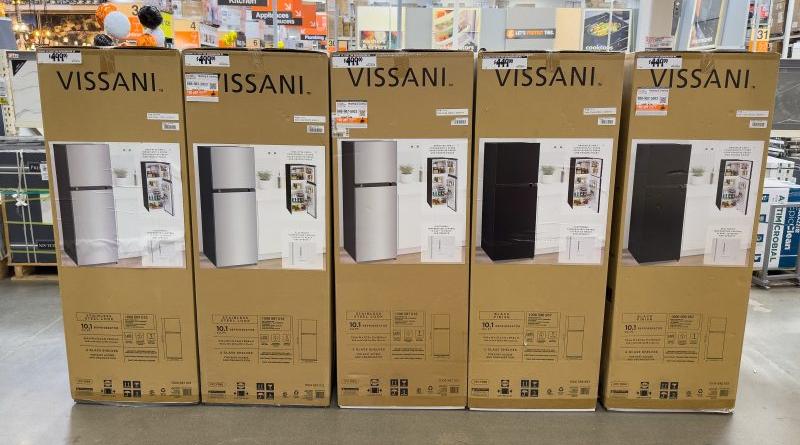Fridges and dishwashers packed in reusable plastic? Bad idea, industry says

Large household appliances will have to be transported almost entirely using reuseable packaging by 2030, according to the European Commission’s proposed packaging waste law, a move widely questioned by players in the supply chain.
The EU’s Packaging and Packaging Waste Regulation (PPWR), tabled in November last year, aims to slash unnecessary boxes and wrappings while promoting recycling as well as reuse.
The proposal, which is currently being examined by the European Parliament and EU member states before eventual adoption, has caused anxiety in the retail and logistics sector, which is still in the process of analysing the implications of the Commission’s proposed reuse targets.
But the white goods sector is confronted with headaches of their own.
Under the Commission’s proposal, 90% of packaging used for large household appliances must be “made available in reusable transport packaging” by 2030 when they are placed on the EU market for the first time.
The mandate is contained in Article 26.1 of the draft regulation, which lays down re-use targets for packaging used in the transport of “large household appliances” such as refrigerators, washing machines, tumble dryers, electric fans or air conditioners.
Whether that objective makes sense is open for debate, though.
The provision “is a significant source of concern for our sector”, said Paolo Falcioni, director general of APPLiA, a trade association representing the home appliance industry in Europe.
According to APPLiA, packaging for large household appliances must be functional and protective, to ensure the product is not damaged physically or by humidity during its journey from the manufacturer to the retailer and eventually to the consumer.
Packaging typically used for this purpose include pallets, plastic straps, carboard boxes, and pallet wrappings, some of which “cannot be reused due to technical constraints”, APPLiA said.
“For example, pallet wrapping may become damaged or contaminated with materials that cannot be adequately cleaned, rendering them unusable for future shipments. In other cases, reuse may be possible, but the cost and complexity of returning the packaging to the manufacturer can make it impractical,” Falcioni told EURACTIV in emailed comments.
Logistics headache
APPLiA is not alone in raising concerns about reusable targets for transport packaging.
FEFCO, the European federation of corrugated board manufacturers, says the proposal could pose huge issues for the logistics and retail sector as a whole, which currently uses disposable corrugated cardboard boxes for protection.
“The entire retail sector will be impacted,” said Eleni Despotou, director general at FEFCO.
In the case of large household appliances, FEFCO says there is “little to no evidence” that existing reusable packaging options – essentially plastic crates – can be scaled up to meet the demands of the entire EU market.
Moreover, plastic crates would need to come in standardised shapes and sizes, resulting in overpackaging for products that don’t fit in the available boxes, FEFCO argues.
Anyway, the case for change is not established, it contends, saying corrugated packaging is already being used in a nearly closed-loop application with high recycling rates, especially when it comes to transport packaging.
“Replacing this proven circular system with inexistent reuse systems does not guarantee better environmental and economic impacts,” Despotou told EURACTIV in emailed comments.
Returnable packaging?
Appliance manufacturers, meanwhile, are also worried about the practicalities of setting up an entirely new system of reusable packaging for white goods.
“The creation of a returnable packaging fleet would require the manufacturing, maintenance, and transport of a large number of empty containers, which is not only costly but also environmentally taxing,” said APPLiA’s Falcioni.
Indeed, reusable containers must be capable of enduring multiple rotations, meaning they must be sturdier and thus heavier than corrugated board, he explained, warning this will result in increased transport-related CO2 emissions.
“While the idea of reusing transport packaging is a worthy one, the practicality of implementing such targets must be evaluated comprehensively,” said Falcioni, who points the finger at the European Commission for failing to conduct a thorough cost-benefit analysis before proposing these targets.
Another open question is whether the reusable packaging target will apply to all international shipments or only to intra-EU ones. Regardless, “returning an empty container from Northern Europe to Southern Europe or vice versa would be a problem,” he told EURACTIV.
Plastic as the alternative
Those criticisms are echoed by PlasticsEurope, an industry association.
Although plastic crates are widely seen as the only viable reusable packaging alternative to corrugated board in transport and logistics, the industry itself has doubts about the idea.
“If you take the 90% reuse target for white goods, we don’t believe the environmental benefits are fully demonstrated,” said David Carroll, director of external affairs at PlasticsEurope.
“There, we don’t think that the alternatives exist and we don’t think the impact has been properly assessed. For instance, we think the amount of produce that will end up lost as opposed to the benefits is not demonstrated.”
The same goes with pallet wrappings – the flexible plastic that goes around transport pallets – Carroll says. “Often the pallet wrapping is there for safety reasons. It’s recyclable, it’s not reusable, and we don’t see reusable alternatives that will perform the same function,” he told EURACTIV.
More widely, Carroll questioned the environmental benefits of setting up a returnable system for reusable plastic packaging.
“Some questions for us are still open. For instance, how many times will it be reused, will it actually be reused, what is the carbon footprint associated with the washing and returning of empty plastic boxes, the reverse logistics, and so on,” he said.
Brussels defends proposal
Despite all the criticism, the Commission seems confident that the 90% reusable packaging target for white goods can be met.
“First of all, the related reuse and refill targets refer to transport packaging and address activities where specific packaging solutions are already available and coupled with reverse logistics available at delivery,” the European Commission replied when asked by EURACTIV about the available solutions.
Asked about the cost of the measure, the EU executive referred to a background study that supported the PPWR proposal, saying it contains “detailed assumptions and methodology used to model the change in mass flows, financial costs, environmental impacts and social (employment) impacts”.
The Commission did not elaborate further.
Others drew attention to the expected benefits in terms of cost savings, CO2 emissions, and reduced packaging waste.
Regarding cost savings, “existing disposable packaging often doesn’t adequately protect products, leading to significant economic losses,” says Rosemarie Wuite from Searious Business, a consulting firm focused on circular plastics solutions.
Product damage, theft, or loss “are notorious cost factors in transport packaging”, Wuite pointed out, saying those can represent 5-8% of total costs for which the retailer often bears the brunt. “This could be brought back to 0% with reusable packaging, resulting in significant margin increases,” she told EURACTIV in emailed comments.
For storage, reusable packaging can also be “stacked from 5 to 8 levels, reducing empty vertical warehouse space,” she added.
Wuite also pointed to existing solution providers such as the Returnable Protective Packaging by Swiss company FreePackNet or the reusable packaging solutions for household appliances, customised by French company Corplex.
“So why waste valuable time and money on opposing or watering down PPWR targets?” she asked, saying the sector needs to act fast in order to meet the 2030 goals laid down in the draft legislation.
[Edited by Nathalie Weatherald]
cover photo:Under the Commission’s proposal, 90% of packaging used for large household appliances must be “made available in reusable transport packaging” by 2030 when they are placed on the EU market for the first time. [ZikG / Shutterstock]






